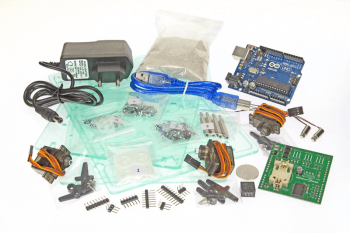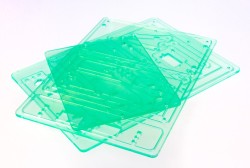Review: Elektor/Make: Sand Clock Kit
 What strikes me immediately, after unpacking the kit, is the absence, in this magnificent pack, of a printed manual. Happily this can be downloaded to read it on the screen. The advantage of this paperless solution is evident (if a tad irritating): you are sure of getting the latest up to date version.
What strikes me immediately, after unpacking the kit, is the absence, in this magnificent pack, of a printed manual. Happily this can be downloaded to read it on the screen. The advantage of this paperless solution is evident (if a tad irritating): you are sure of getting the latest up to date version.
Assembly Manual
This document has no fewer than 30 pages. It is illustrated by numerous color photos. All this inspires confidence in the reader and it is worth printing. In any case, prior reading, from beginning to end, is advised to acquire and overview of the assembly, even if some details only become significant later on. Follow all the instructions scrupulously. The assembly time given in the instructions is about 2 hours. That seems optimistic to me, I’d allow half as much again. But everyone works at his own pace!The tools
You will obviously need a computer on which is installed an Arduino programming environment. You'll also need several standard tools: scissors (for unpacking); a fine-point soldering iron; a pair of cutters (to separate the shield form its support); tweezers; a set of Phillips screwdrivers; a pencil sharpener and some stickytape. Useful but not absolutely necessary are a file (to trim the shield board); long nose pliers (to hold the screws during assembly); a ruler or some calipers (to make sure you have the right size screws) and an antistatic cloth (to wipe away finger marks).Peel off the film
 After arranging on your workbench all the parts which cannot be confused, there is an unexpected task: peel off the protective film which protects the three PMMA panels. As these are pre-cut, so is their protective film; so it is necessary to repeat this operation on each piece, top and bottom. I found this fiddly, but I resisted the temptation to use a metallic tool in the hope of making it quicker. It would be a pity to scratch the panels, because their laser-cutting is perfect, the edges are absolutely sharply cut.
After arranging on your workbench all the parts which cannot be confused, there is an unexpected task: peel off the protective film which protects the three PMMA panels. As these are pre-cut, so is their protective film; so it is necessary to repeat this operation on each piece, top and bottom. I found this fiddly, but I resisted the temptation to use a metallic tool in the hope of making it quicker. It would be a pity to scratch the panels, because their laser-cutting is perfect, the edges are absolutely sharply cut. Here is the order of operations: you start by soldering several through-hole components on the shield, then you can quickly test the Arduino, the shield and the servomotors (which should be in the middle position), then you assemble almost all the mechanical parts, and integrate the electronics. Then comes the calibration and finalizing the mechanical assembly. Only unpack the sand at the end. The instructions seemed to me clear, especially after reading them fully first. The tightening of some of the screws which screw directly into the PMMA (no nuts) demands some dexterity; on one hand the manual advises to tighten them to reduce the play in the parts, and on the other hand recommends not forcing them to avoid cracking the parts. This can be unnerving for the inexperienced.
Here is the order of operations: you start by soldering several through-hole components on the shield, then you can quickly test the Arduino, the shield and the servomotors (which should be in the middle position), then you assemble almost all the mechanical parts, and integrate the electronics. Then comes the calibration and finalizing the mechanical assembly. Only unpack the sand at the end. The instructions seemed to me clear, especially after reading them fully first. The tightening of some of the screws which screw directly into the PMMA (no nuts) demands some dexterity; on one hand the manual advises to tighten them to reduce the play in the parts, and on the other hand recommends not forcing them to avoid cracking the parts. This can be unnerving for the inexperienced.
So what to do, boss?
 Faced with some tight screws, I proceeded very slowly, tightening, untightening, retightening without interruption, several times for each screw, patiently going a little bit further each tightening. Slightly heated by friction, the screw penetrates progressively without cracking the transparent material.
Faced with some tight screws, I proceeded very slowly, tightening, untightening, retightening without interruption, several times for each screw, patiently going a little bit further each tightening. Slightly heated by friction, the screw penetrates progressively without cracking the transparent material.The designer of the kit, when I consulted her on this point, confirmed her choice of using screws without lock-nuts, after exhaustive tests of various options. Thanks to her experience with PMMA, she assured me that this is how to obtain the best mechanical stability of the pantograph, and the best precision of the trace in the sand, because the screws of the pantograph remain quite firm despite the vibrations of the mechanism.
Read full article
Hide full article


Discussion (17 comments)